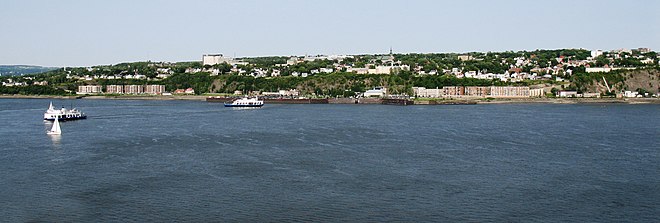Lévis
| Lévis | ||
|---|---|---|
 |
||
 coat of arms |
 flag |
|
| Motto : Toujours à l'Avant-Garde | ||
| Location in Quebec | ||
|
|
||
| State : |
|
|
| Province : | Quebec | |
| Administrative region : | Chaudière Appalaches | |
| MRC or equivalent : | Lévis | |
| Coordinates : | 46 ° 48 ′ N , 71 ° 11 ′ W | |
| Height : | 20 m | |
| Area : | 449.31 km² | |
| Residents : | 143,414 (as of 2011) | |
| Population density : | 319.2 inhabitants / km² | |
| Time zone : | Eastern Time ( UTC − 5 ) | |
| Municipality number: | 25213 | |
| Postal code : | G6, G7 | |
| Mayor : | Danielle Roy-Marinelli | |
| Website : | ville.levis.qc.ca | |
Lévis (officially Ville de Lévis ) is a city ( ville ) and at the same time a territorial equivalent to an MRC in the Canadian province of Québec .
It is also the administrative center of the Chaudière-Appalaches administrative region .
The city is located on the south bank of the Saint Lawrence River directly opposite the provincial capital Québec at the mouth of the Chaudière River between Beaumont and Saint-Antoine-de-Tilly. In 2016 it had 143,414 inhabitants.
history
The origins of the city of Lévis go back to the French colonial days of New France . Samuel de Champlain , who founded the city of Québec in 1608, named the small headland at the mouth of the Chaudière on the opposite south bank Cap-de-Lévis, after Henri de Lévis, the viceroy of New France at the time. In 1636, Jean de Lauzon, the then governor of New France, received the feudal rights for the area of today's city of Lévis, which was still predominantly populated by hostile Iroquois . He founded the Seigneurie Lauzon, but it was not until 1647 that Guillaume Couture achieved a peace agreement with the Iroquois and thus the official colonization of the area. The place name Pointe-de-Lévy was introduced and in 1694 Saint-Joseph-de-la-Pointe-Lévis was finally founded as the first and initially only municipality in the Seigneurie Lauzon.
In 1836 the Seigneurie Lauzon disappeared as a result of the insolvency of the last liege, John Caldwell. The area was put up for sale and finally, after long legal disputes, acquired by the government in 1845 and divided into two parts. In the following years u. a. the municipalities of St-Romuald de l'Etchemin (1855) and St-David de l'Auberivière (1876) were founded. The original municipality of Saint-Joseph-de-la-Pointe-Lévis was renamed the municipality of Lauzon in 1867, which finally received city rights in 1910.
The city of Lévis was founded on May 18, 1861 on the initiative of Pastor Joseph-David Déziel as a merger of the parish of Notre-Dame-de-la-Victoire and the city of d'Aubigny. The name was given in honor of the Chevalier von Lévis, Marshal François-Gaston , under whose command the British were defeated at the Pointe-de-Lévis in the Battle of Sainte-Foy in 1760 with great losses.
Lévis has been part of the Communauté métropolitaine de Québec association since 2002 .
Administrative division
Lévis administrative area
A series of administrative reforms were carried out between 1989 and 2002, at the end of which the original county of Lévis was divided into three of the administrative units, Municipalité régionale de comté , created in 1979 . The administrative area of Lévis now consists of the MRC Municipalités régionale de comté
- Désjardins
- Chutes-de-la-Chaudière-Est
- Chutes-de-la-Chaudière-Ouest
City of Lévis
With the start of the major administrative reforms in September 1989, the cities of Lévis and Lauzon were combined to form the city of Lévis-Lauzon. After disagreements regarding the naming, a referendum was finally held in autumn 1990 in order to come to a decision on the name that was legitimized by the people. Due to this referendum, the city was renamed Lévis on February 22, 1991.
On January 1, 2002, in the course of the second phase of the administrative reforms, nine more localities were incorporated into the city of Lévis as part of a comprehensive, provincial reorganization. The Ville de Lévis has since consisted of the ten districts
- Lévis
- Charny
- Pintendre
- Sainte-Hélène-de-Breakeyville
- Saint-Etienne-de-Lauzon
- Saint-Jean-Chrysostome
- Saint-Joseph-de-la-Pointe-de-Lévy
- Saint-Nicolas
- Saint-Rédempteur
- Saint-Romuald
heraldry
The coat of arms of the city of Lévis comes from the family of the patron saint François-Gaston de Lévis. François-Gaston came from a branch of the House of Lévis, a vassal house of the House of Montfort-l'Amaury .
- Symbols
The heraldic designation ( blazon ) of the coat of arms reads:
D'or à trois chevrons de sable
Demographics
Population by MRC and age groups (2005)
| Chaudière-Ouest | Chaudière-est | Desjardins | Lévis | |
|---|---|---|---|---|
| 0-14 years | 6518 | 7811 | 7040 | 21369 |
| 15–24 years | 4780 | 4339 | 6842 | 15961 |
| 25–64 years | 20323 | 27338 | 27763 | 75424 |
| 65 years and + | 1805 | 3905 | 7932 | 13642 |
| Total population | 33426 | 43393 | 49577 | 126396 |
Population composition (2006)
The last population growth of the city of Lévis was 1.3% in 5 years. Lévis is one of the most homogeneous Canadian communities: over 99% of the population have European ancestry and over 97% are French native speakers. Immigrants and members of the indigenous population ( premières nations ) form a comparatively small minority. The median income is around 20% above the provincial average and the unemployment rate is around half the provincial average.
| City of Lévis | Quebec Province | |
|---|---|---|
| Middle age of the inhabitants | 39.4 years | 41.0 years |
| french Native speaker | 97.45% | 79.05% |
| immigrant | 1.55% | 11.45% |
| Canadian citizens | 99.44% | 96.23% |
| Residents of the premières nations | 0.30% | 1.46% |
| Unemployed | 3.6% | 7.0% |
| Average earnings | $ 29,710 | $ 24,430 |
Source: Statistics Canada
economy
Lévis is the largest agglomeration and at the same time the economic center of the administrative region of Chaudière-Appalaches. The city of Lévis accounts for around a third of the population and the economic turnover of the administrative region Chaudière-Appalaches.
The economic importance of the city of Lévis is largely due to the presence of several large commercial companies, including:
- Frito-Lay Canada (potato snacks)
- Davie Québec (shipyard)
- Ultramar ltée (petroleum refinery)
- Teknion Roy & Breton Inc. (furniture)
- Caisses Desjardins (Cooperative Bank)
The Hydro-Québec operates in the city one of the largest substations in Canada, including the so-called Lévis de-icer , a plant for de-icing of overhead lines .
Infrastructure
Transport links
In addition to a ferry from the Société des traversiers du Québec , which connects Québec with the old town of Lévis, two important bridges between Lévis and Québec cross the Saint Lawrence River. In addition to road traffic , the Québec Bridge , completed in 1919, also carries rail and pedestrian traffic, whereas the Pont Pierre-Laporte, completed in 1970, serves exclusively as a motorway bridge .
In 1854 Lévis was connected to the Grand Trunk Railway . The route along the St. Lawrence Valley leads southeast via Richmond to Montreal and on across Ontario to Chicago . It leads northwest along the south bank of the St. Lawrence River in the Gaspésie to Rimouski and on to Nova Scotia and Maine .
In 1920 the route became the property of Canadian National and is now operated by its subsidiary, the Grand Trunk Corporation.
Higher educational institutions
- Cégep de Lévis-Lauzon
- Université du Québec à Rimouski , Campus de Lévis
Important personalities in the city
- Louis-Honoré Fréchette (1839–1908), writer
- Louis-Nazaire Bégin (1840–1925), Roman Catholic Archbishop of Québec
- Alphonse Desjardins (1854–1920), co-founder of the first credit union in North America
- Joseph-Arthur Bernier (1877–1944), composer, organist, pianist and music teacher
- Jean Carignan (1916–1988), fiddle player
- Pierre Morency (* 1942), writer
- André Lacroix (* 1945), ice hockey player
- Ginette Bellavance (* 1946), composer, singer and actress
- Celine Bonnier (* 1965), actress
- Ariane Moffatt (* 1979), singer-songwriter
- Michel Léveillé (* 1981), ice hockey player
- Charles Hamelin (* 1984), short tracker
- Pierre-Luc Létourneau-Leblond (* 1985), ice hockey player
- Kalyna Roberge (* 1986), short tracker
- Marie-Michèle Gagnon (* 1989), ski racer
- Francis Bernier (born 1997), singer
Town twinning
-
 Le Grand-Quevilly (France), since 1969
Le Grand-Quevilly (France), since 1969
Web links
Individual evidence
- ^ Population and dwelling counts, for Canada and census subdivisions (municipalities), 2016 and 2011 censuses. Statistics Canada, accessed August 1, 2017 .
- ^ Community Profile Lévis. Statistics Canada, accessed August 14, 2012 .
- ^ Lévis et Grand Quevilly depuis plus de 40 ans! (PDF; 487 kB) Archived from the original on March 22, 2016 ; Retrieved on August 14, 2012 (French).







